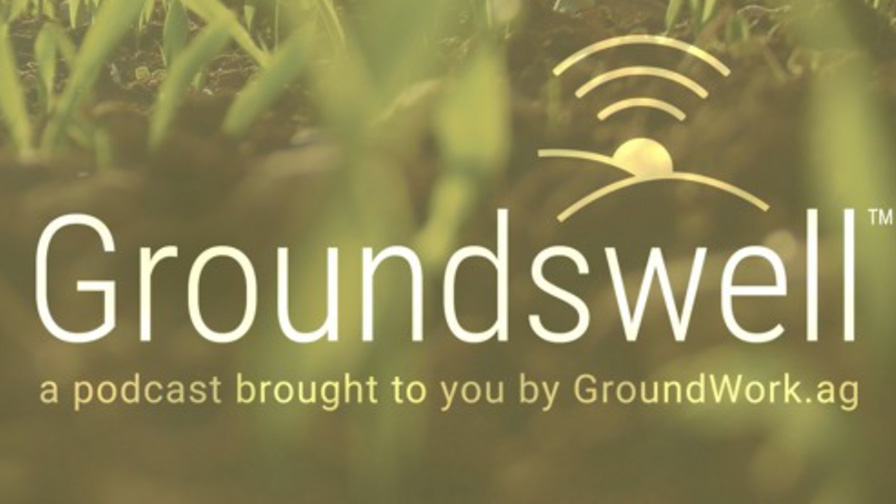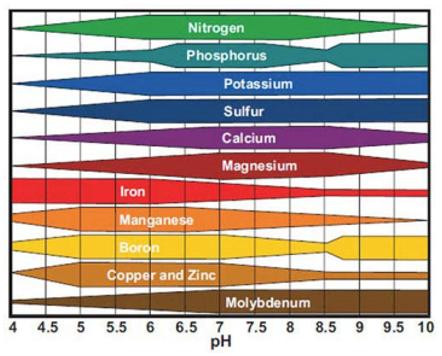What’s Best: Micronutrient Deficiency Prevention or Correction?

While some growers want the insurance that a preventative micronutrient application can provide, others opt to wait to until deficiencies show. Pictured: zinc deficiency in corn.
Editor’s note: This article originally published in April 2021.
The use of micronutrients is a heavily debated topic with two major points of view. While some growers want the insurance policy that a preventative micronutrient application can provide, others opt to wait to apply micronutrients until deficiencies are shown in the plant or on a tissue sample test result. While both methods have merit, preventative micronutrient applications, when included in passes already made across the field, can reduce plant health and yield loss from deficiency and nutrient tie-up.
Preventative applications are especially beneficial for crops with high micronutrient response rates. As shown in the chart below, growers planting most crops will benefit from proactive micronutrient applications. A proactive approach is especially important since tissue samples, while great tools, do not provide immediate feedback. Additionally, many growers in the Midwest will face inclement weather that could delay passes across the field. Therefore, a proactive application could have compounding benefits for preventing yield loss and maintaining plant health.

Maintaining Availability
An example of a micronutrient that is highly responsive in most crops is zinc. Corn, specifically, responds to early zinc applications at planting even if zinc levels in the soil may seem “adequate.” There is a big difference between the nutrient levels you read on a soil test and what is actually available to the crop. This is due to complex interactions between many soil factors that will be discussed later in this article.
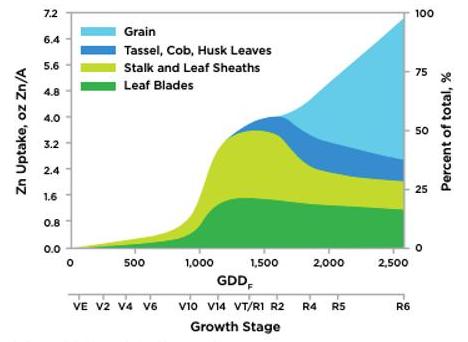
Corn Zinc Demand Curve. Source: Nutrient Uptake, Partitioning, and Remobilization in Modern, Transgenic Insect-Protected Maize Hybrids. Ross R. Bender, Jason W. Haegele, Matias L. Ruffo, and Fred E. Below (2013).
Therefore, applying this important micronutrient via a starter fertilizer at planting can ensure that plants have adequate amounts of plant-available zinc. However, it’s important to remember that the need for zinc, like many other micronutrients, spikes between V10-V14, so additional applications may be required in-season to keep adequate amounts of zinc available.
For the best response from micronutrients, it may take multiple applications that align when the plant really needs it. For applications later in the season, the best way to apply micronutrients is through foliar feeding. This method bypasses the need for the plant to absorb the nutrient through the soil. This method is the most effective for micronutrients that are needed in small amounts and can be easily absorbed and used by the leaves.
However, for certain micronutrients, foliar feeding is not the best method. That’s because when applying via a foliar method, micronutrients don’t translocate through the plant. Boron, for instance, should be fed through roots vs sprayed on via a foliar method. Boron will translocate throughout the plant if taken up through the roots, to where they are needed in the plant. Therefore, it’s important to know the best way to apply micronutrients based on their mobility in the plant.
Finding Balanced Nutrition – Mobility and Uptake
Maintaining the mobility, availability and uptake of micronutrients in plants requires not only proper placement, but also balance between macro and micronutrients. The presence of too much of one nutrient can hinder another’s availability and mobility into the plant. Similarly, the absence of certain micronutrients can hinder the availability of others.
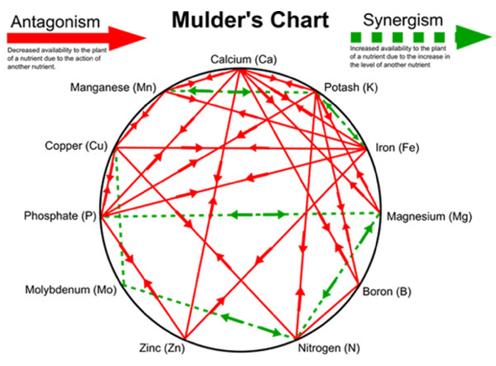 For instance, potassium (K) and magnesium (Mg) have an antagonistic relationship, meaning when the saturation of K present in the soil is high, it inhibits the uptake of Mg in the plant. The opposite is true for Mg saturation in the soil. The K/Mg ratio is often used to measure how available each nutrient is in the soil. When the K/Mg ratio is <0.2 the plant will have trouble with K uptake. This is because Mg in the soil is overpowering K. When the K/Mg ratio is >0.3 the plant may have trouble accessing Mg because K is overpowering the Mg. Many other relationships such as this exist, as shown by the red antagonism relationships on Mulder’s Chart.
For instance, potassium (K) and magnesium (Mg) have an antagonistic relationship, meaning when the saturation of K present in the soil is high, it inhibits the uptake of Mg in the plant. The opposite is true for Mg saturation in the soil. The K/Mg ratio is often used to measure how available each nutrient is in the soil. When the K/Mg ratio is <0.2 the plant will have trouble with K uptake. This is because Mg in the soil is overpowering K. When the K/Mg ratio is >0.3 the plant may have trouble accessing Mg because K is overpowering the Mg. Many other relationships such as this exist, as shown by the red antagonism relationships on Mulder’s Chart.
Fixation and Chelates
While deficiencies in micronutrients in the soil have become more common, deficiency in plants can most often be attributed to fixed or unavailable nutrients in the soil rather than a lack of nutrients. Soil conditions such as CaCO3 concentration, pH, organic matter, soil moisture, Fe and Al oxides and phosphorus levels can all reduce the availability and benefits of micronutrients.
One way to remedy bound nutrients is through the use of chelates. A chelate is an organic ring compound that holds metal ions and keep them available in the soil. Chelation is one of the simplest, most effective ways to provide more efficient and available crop nutrition. Chelation can make nutrients available in a usable form ready for plant uptake and improved utilization. Chelates overcome ionic bonds in the soil often intensified by pH and organic matter, help pull micronutrients into the soil solution, and makes them more available to the plant. One of the best chelates for nutrient uptake is an ortho-ortho EDDHA chelate. The structure of this chelate makes it very stable, allowing the chelate to last for a longer amount of time in the soil than most other kinds of chelates.
Unlocking Micronutrients
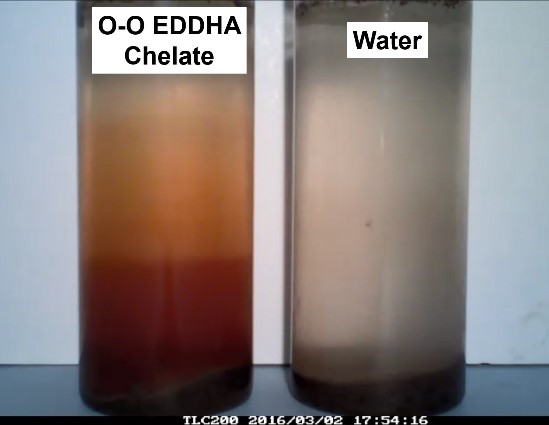 As an example of how an ortho-ortho EDDHA chelate works, the image to the right shows how micronutrients are extracted from soil placed at the bottom of a column. The column on the left contains an ortho-ortho EDDHA chelate while the column on the right only contains water. The column containing the ortho-ortho EDDHA chelate is a reddish color because micronutrients such as Fe, Mn, Cu and Zn that were tied up in the soil are being made available while the column containing water stays clear which indicates no extraction taking place.
As an example of how an ortho-ortho EDDHA chelate works, the image to the right shows how micronutrients are extracted from soil placed at the bottom of a column. The column on the left contains an ortho-ortho EDDHA chelate while the column on the right only contains water. The column containing the ortho-ortho EDDHA chelate is a reddish color because micronutrients such as Fe, Mn, Cu and Zn that were tied up in the soil are being made available while the column containing water stays clear which indicates no extraction taking place.
The “extracted” liquid was then sent in for analysis of what nutrients were made available by adding an ortho-ortho EDDHA chelate. This experiment was then re-run with multiple soil types. The charts below exhibit the increase in available micronutrients in various soils once the ortho-ortho EDDHA chelate was added compared to when water was added to various types of soil.
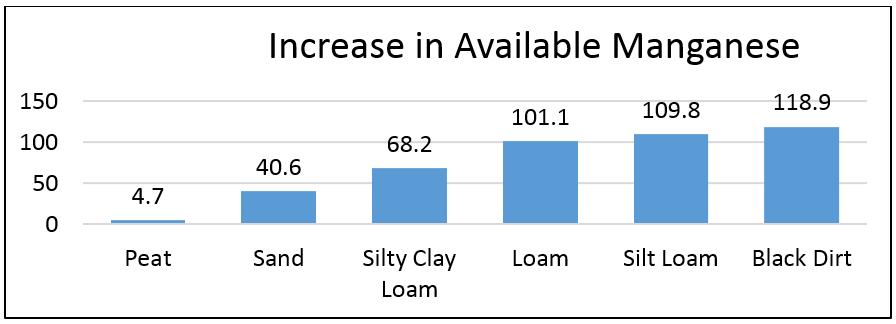



One product containing the patented ortho-ortho EDDHA chelate is Levesol Zn from CHS Agronomy, which was designed to significantly enhance nutrient availability when applied with liquid starter fertilizers. The Levesol chelate makes micronutrients resting in the soil and in liquid fertilizers, such as zinc, iron, copper and manganese, all more soluble for early uptake. After uptake, the Levesol chelate increases the rate of micronutrient translocation within the plant. This allows developing crops to utilize micronutrients more efficiently during early development, increasing speed of emergence, overall plant health, and ultimately yield.



